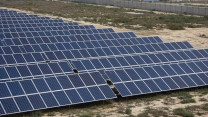Cotton supply from farms soars 66.5%
Increased crop arrivals spark hopes of producing 10 million bales this season

The supply of cotton by farmers for processing in ginning factories has increased sharply, rekindling hopes that overall production this season will exceed 10 million bales following dismal harvests over the past few years.
The Pakistan Cotton Ginners Association on Thursday reported that by August 1, 2023, around 1.428 million bales had reached factories across Pakistan. The latest numbers released by the association showed a 66.5% year-on-year rise in supplies from farms.
Cotton arrivals at ginning units in Punjab rose around 95% when compared with the arrivals last year. The province has so far managed to produce 388,568 bales of cotton.
Sindh also recorded a significant increase of 57.8% in cotton arrivals at the beginning of August and produced 1.04 million bales. Pakistan is a major cotton producing nation but the harvest of this vital crop has plunged in recent years as farmers switched over to other crops.
Despite efforts, the country has failed to ramp up the production of cotton, which is a basic raw material for textile products. Apart from that, cotton is itself an export commodity that can bring a significant amount of foreign exchange. As cotton farmers fail to meet the massive demand of textile producers estimated at 16 million bales, many textile exporters have to import cotton to meet their requirement.
Pakistan’s average cotton production currently stands in the range of 10 to 12 million bales per annum, way short of the dream of pushing output to 20 million bales. Last year’s devastating floods, which ravaged large swathes of agricultural land, sparked a cotton crisis as the country was able to produce only 4.9 million bales in the sowing season of 2022-23, the lowest in around four decades.
The harvest was 34% lower than the previous planting season when Pakistan harvested 7.44 million bales.
For the current year, the cotton crop target has been set at 12.77 million bales. For this purpose, 6.834 million acres of land has been cultivated across the country.
Farmer lobbies emphasise that the balanced use of fertiliser is a prerequisite for the increase in per-acre yield of different crops, especially cotton, wheat, rice, sugarcane and maize.
The production of cotton crop has already plunged 65%, ie from 14 million bales in 2014 to less than 5 million bales in 2022-23. To meet the textile industry’s requirement of 16 million bales, the country is compelled to spend foreign currency worth $4 billion in 2023-24 to maintain overall export earnings around $25 billion.
Published in The Express Tribune, August 4th, 2023.
Like Business on Facebook, follow @TribuneBiz on Twitter to stay informed and join in the conversation.


















COMMENTS
Comments are moderated and generally will be posted if they are on-topic and not abusive.
For more information, please see our Comments FAQ